- Repair vs. Replace
- A Few Basics
- Owner Options
- MotorMaster+ Provides Analytical Tools
- Company Energy Policy
- Three Scenarios
- New Motor
- Repair or Replacement of a Failed Motor
- Retrofitting a Serviceable Motor
- Going Beyond the Standards
- Big Savings
- MotorMaster+
- High-Efficiency Transformers, Too
- The Principals
The Weyerhaeuser Company, one of America's leading forest products producers, gives top priority to environmental issues - not surprising for a company that depends on renewable resources. Besides using their forests wisely, Weyerhaeuser made a corporate policy decision to pursue "green" policies like utilizing more than 98% of its raw materials and by burning its organic residues in waste-heat-recovery boilers, which generate enough electricity for two-thirds of its energy needs. Smart ideas like that regularly win the company awards from government agencies, industry groups, the financial community and environmental organizations.
 Weyerhaeuser's Longview Complex, in Longview, Washington, is one of 280 company facilities that now save money with high-efficiency motors and transformers, thanks to a company-wide energy policy.
Weyerhaeuser's Longview Complex, in Longview, Washington, is one of 280 company facilities that now save money with high-efficiency motors and transformers, thanks to a company-wide energy policy.Repair vs. Replace
Generating power from wood waste makes a lot of sense, but making the effort worthwhile means energy usage must be efficient, too. So, in 1995, Weyerhaeuser established a company-wide policy to reduce energy consumption and costs and to minimize the impact of its huge power requirements on the environment.
Electric motors are a key element of that policy. Why electric motors? Because they account for the largest single share of Weyerhaeuser's energy bill, as they do in many manufacturing industries. In the USA alone, motors account for about two trillion kilowatt-hours of power usage annually. Motors are clearly the first place to look if you want to save electrical energy.
It's also the law. A federal statute, the Energy Policy Act of 1992 (EPAct), requires that certain types of new motors sold in the USA as of October 24, 1997, must meet or exceed specified efficiency ratings.
EPAct didn't result in the invention of high-efficiency motors; motors meeting the new ratings were commercially available long before the law took effect, and many more have come on the market since then. Nor does EPAct require replacement of old motors; a grandfather clause allows users to repair or rewind them if they wish.
Rewinding/rebuilding a motor might improve its efficiency above the value at the time the motor was taken out of service. But because the amount and configuration of the motor steel remains fixed and no additional copper can be added, the rebuilt motor's efficiency can only attain its original value, at best, which may be lower than that of currently available models. Therefore, for reasons explained below, repair often isn't the most cost-effective practice, as Weyerhaeuser and other companies have learned.
Back to TopA Few Basics
It might be helpful to define some efficiency terms as they are used today:
Standard-Efficiency Motors include many (but not all) motors manufactured before EPAct took effect in 1997. In the years leading up to EPAct's effective date, manufacturers gradually dropped these motors from their product lines and replaced them with more efficient models. The average efficiency of standard-efficiency motors is higher than that of older motors but, according to a database assembled for the DOE (more about that later), it is only about 89.3% for a general-purpose, TEFC, NEMA Design B, 20-hp, 460-V motor. New motors of this type can no longer be sold in the USA.
EPAct Energy-Efficient Motors are those meeting the standards of the 1992 law. Nominal efficiency values for each type and size of motor covered by the law are spelled out in Table 12-11 of the National Electrical Manufacturers Association publication, NEMA MG 1-1998 (Revision 3). 1 Motors covered under EPAct are of the general-purpose, T-frame, single-speed, squirrel-cage, induction type; 230/460-V, NEMA Designs A or B, continuous rated, 60 Hz, from 1-200 hp, 2-, 4- and 6-pole (3600-, 1800- and 1200-rpm), open and enclosed. EPAct doesn't address special-purpose motors or motors of sizes, frames, speeds or voltages other than those listed. In contrast to the "standard-efficiency" motor described above, a 20-hp, 1800-rpm, EPAct Energy-Efficient motor must exhibit a minimum nominal efficiency of 91.0% at 100% load.
NEMA Premium™ Motors exceed EPAct efficiency requirements by one to two percentage points, and constitute the definition of premium efficiency as we use the term here. In the past, there were various definitions for "high efficiency," including those published by the Consortium for Energy Efficiency (CEE), a Boston-based organization that promotes better energy utilization. Starting in 2001, CEE's premium specifications, which include motors up to 200 hp, now conform with those of the new NEMA Premium standard except that the latter extends to motors through 500 hp. 2 A 4-pole, TEFC, 20-hp NEMA Premium motor must exhibit a rated nominal full-load efficiency of at least 93%.
Table 1 illustrates the difference in these motors. Data for standard-efficiency motors were taken from MotorMaster+. EPAct data were taken from Table 12-11 and NEMA Premium efficiency data from Tables 12-12 and 12-13 of NEMA MG 1-1998 (Revision 3). Efficiencies listed are for general-purpose motors, NEMA Design A or B, TEFC, 4-pole (1800-rpm), continuous duty.
Back to TopOwner Options
Owners have three choices when an old motor fails or approaches the end of its expected life:
- Repair/Rewind. This option can cost up to 80% of the price of a new motor, but it doesn't improve an old motor's efficiency beyond its original rating, which is locked in by its basic design. Rewound motors usually consume just as much power, or maybe more, as they did when they were new, and thus cost at least as much to operate.
- Replace the motor with an EPAct Energy-Efficient Motor (assuming the motor in question is covered by EPAct). The resulting energy savings can recover the initial cost of the new motor within a few years or less. And, as Weyerhaeuser learned, new motors tend to last longer than old, rebuilt ones.
- Replace the motor with a NEMA Premium-efficiency model. This option can produce the fastest payback and result in the highest total cost savings over the life of the motor. This is essentially the option Weyerhaeuser chose. However, the company operates or maintains as spares about 87,000 motors, and potentially replacing thousands of them as a matter of company policy involved a lot of analysis.
At Weyerhaeuser, setting criteria to choose the correct option fell to John Holmquist, P.E., Senior Scientist, Electrical Power and Energy, Weyerhaeuser Engineering. Holmquist is an electrical engineer and a Life Fellow Member of the Institute of Electrical & Electronics Engineers (IEEE).
Holmquist took a broad view of his assignment. "Our goal was to reduce the total cost of ownership for our motors," he wrote in an IEEE publication. 3 "Total cost includes not just the purchase price, but also the cost of electric power consumption and repair costs over the lifetimes of our motors. We specifically wanted to know if we could lower our overall costs by replacing our standard-efficiency motors with higher efficiency models, which sometimes cost a bit more initially, or whether it was cheaper to repair the old motors and continue to use them.
"We also wanted to increase the reliability and service life of our equipment. Naturally, we expected that new motors would last longer than older, rebuilt ones, but we didn't know if longer life justified the higher cost of replacement."
Back to TopMotorMaster+ Provides Analytical Tools
To answer those questions, Holmquist enlisted the assistance of Gilbert A. McCoy, P.E., energy systems engineer and Johnny G. Douglass, P.E., senior engineer at the Washington State University Energy Program in Olympia. It was the WSU Energy Program that, several years earlier, had authored MotorMaster+ software for the U.S. Department of Energy's (DOE) Motor Challenge Program (see sidebar on page 5). Holmquist also called in Jim Rooks, P.E., of J&R Consulting, Inc. Like John Holmquist and the WSU team, Rooks had had many years of experience dealing with motor efficiency, and he was thoroughly familiar with Weyerhaeuser's operations.
Rooks used MotorMaster+ to analyze a representative sample - several hundred units - of Weyerhaeuser's motors. (The company owns 57,000 operating electric motors, plus 30,000 spares held in inventory.) They looked at motors that were operating satisfactorily, ones that were scheduled for repair or rewind, stocked replacements and new motors that had been specified but not yet purchased ( Figures 1 and 2).
 Figure 1. A pair of IEEE 841, premium-efficiency motors drive white water (a process fluid) pumps at Weyerhaeuser's Springfield, Oregon, mill. IEEE 841 motors are designed for duty in harsh environments. While they are not separately listed under the NEMA Premium standard, more than one-half of IEEE 841 motors described in MotorMaster+, including the ones shown here, meet or exceed NEMA Premium efficiency ratings.
Figure 1. A pair of IEEE 841, premium-efficiency motors drive white water (a process fluid) pumps at Weyerhaeuser's Springfield, Oregon, mill. IEEE 841 motors are designed for duty in harsh environments. While they are not separately listed under the NEMA Premium standard, more than one-half of IEEE 841 motors described in MotorMaster+, including the ones shown here, meet or exceed NEMA Premium efficiency ratings.Company Energy Policy
MotorMaster's Inventory program can record each motor's nameplate data, age, utilization rate (operating hours per year), rated operating efficiency, and loading (as measured by ammeter readings and rewind history), plus any special electrical and mechanical characteristics. The software then compares the cost of continuing to operate the motor over its expected life with the total cost of ownership of a premium-efficiency motor of equivalent size.
The resulting database gave John Holmquist and the Weyerhaeuser team the information they needed to propose three wide-ranging corporate policies:
- All non-IEEE 841 motors 50 hp or smaller that fail should be replaced with energy-efficient IEEE 841-2001 models regardless of the condition, age or rebuild history of the existing motor.
IEEE 841 motors are severe-duty versions of TEFC, NEMA T-frame designs originally used in the petroleum and chemical industries. They are not specifically mentioned in either the EPAct or NEMA Premium standards. In fact, Weyerhaeuser was well ahead of the curve at the time, because the NEMA Premium designation didn't exist when the company made its policy decision. More than half of the IEEE 841 units listed in MotorMaster+ meet or exceed NEMA Premium efficiency ratings.
 Figure 2. A high-efficiency 1250-hp, 3600-rpm, 2300-V, WP-1 enclosure, constant-speed motor, left, drives an aeration blower at Weyerhaeuser's Longview Complex. Motors of this size and type are not covered by EPAct or the NEMA Premium designation, yet Weyerhaeuser demands that they display guaranteed high efficiencies comparable to the best motors available.
Figure 2. A high-efficiency 1250-hp, 3600-rpm, 2300-V, WP-1 enclosure, constant-speed motor, left, drives an aeration blower at Weyerhaeuser's Longview Complex. Motors of this size and type are not covered by EPAct or the NEMA Premium designation, yet Weyerhaeuser demands that they display guaranteed high efficiencies comparable to the best motors available.- All non-IEEE 841 Motors should be evaluated for retrofitting.
MotorMaster+ would be used to project life-cycle costs in order to determine whether the serviceable motor should be replaced. If so, only premium-efficiency IEEE 841 motors would be acceptable. - All failed motors 60 hp and larger should be rebuilt according to uniform company specifications. The company's rebuild policy included thorough inspection and testing, accurate recordkeeping, carefully controlled stripping under controlled conditions, adherence to manufacturers' recommendations and performance of a financial analysis.
Heretical as it sounds, retrofitting serviceable motors before their scheduled rewind dates can make sense because a motor's operating cost far exceeds its purchase price when the motor is operated at a high duty cycle. At Weyerhaeuser mills, duty cycles average 87.5%. High-efficiency motors would therefore save money over their entire service lives. Payback times would be short, even at relatively low utility rates.
Three Scenarios
John Holmquist illustrated the preceding points in his previously mentioned paper presented to the Pulp & Paper Industry Technical Conference held in Portland, Maine, in 1998. 4 He looked at three scenarios:
- Buying a motor for a new application
- Repairing or replacing a failed motor
- Retrofitting an existing serviceable motor
New Motor
The following is based on the referenced paper (see Table 2):
Consider a 75-hp, 1800-rpm motor, running 8,760 hours a year loaded to 80% load factor. Assume a base energy cost of $0.04/kWh, and use the MotorMaster+ Life Cycle Cost program to compare one-year operating costs, 10-year operating costs and life-cycle costs for motors offered by three suppliers. Incidentally, none of the motors listed below meets NEMA Premium standards, and motors "A" and "B" also fall short of EPAct efficiency requirements.
At a power cost of $0.04/kWh, 1-year operating costs are most often between five and six times a motor's purchase price. The average U.S. electric rate, almost $0.07/kWh in 2000, was higher than the rate Weyerhaeuser was paying at the time. At the higher average rate, it is not unusual for motors operating at 100% duty cycles to consume power costing 15 to 25 times their purchase price in electric power per year.
But even at $0.04/kWh, the high-efficiency motor from Supplier C would save $12,261 in life-cycle cost when compared to the lowest price motor (Supplier A). Mr. Holmquist correctly observed that "The purchase price is almost insignificant compared to the operating costs over the life of the motor."
| hp | Standard-Efficiency Motors Average Efficiency at 100% Load | EPAct Energy-Efficient Motors Minimum Nominal Efficiency at 100% Load | NEMA Premium Motors Minimum Nominal Efficiency at 100% Load |
|---|---|---|---|
| 5 | 83.3 | 87.5 | 89.5 |
| 10 | 85.7 | 89.5 | 91.7 |
| 20 | 88.5 | 91.0 | 93.0 |
| 25 | 89.3 | 92.4 | 93.6 |
| 50 | 91.3 | 93.0 | 94.5 |
| 100 | 92.3 | 94.5 | 95.4 |
| 200 | 93.5 | 95.0 | 96.2 |
| Supplier | A | B | C |
|---|---|---|---|
| Efficiency | 89.5% | 91.7% | 95.0% |
| Purchase Price | $ 2,800 | $ 3,000 | $ 3,300 |
| 1-Year Operating Cost | $ 17,524 | $ 17,103 | $ 16,509 |
| 10-Year Operating Cost (Includes 5% escalation/year) |
$220,413 | $215,124 | $207,652 |
| Life-Cycle Cost | $223,213 | $218,124 | $210,952 |
| Table from J. Holmquist 3 | |||
Repair or Replacement of a Failed Motor
In one case, Holmquist looked at the repair-or-replace choice for a failed 50-hp, 1800-rpm, TEFC motor rated for continuous duty. The replacement motor, an IEEE 841 design, has a rated efficiency of 94.5%, which also meets NEMA Premium standards for general-purpose motors of that size. The factors considered:
- Existing motor efficiency (nominal): 89.6%
- Premium-efficiency IEEE 841 motor (nominal): 94.5%
- Annual energy cost savings (@ $0.04/kWh): $605
- Repair price, rewind only: $980
- Price of a new, premium-efficiency IEEE 841 motor: $1,507
- Price differential +$527
With its annual savings of $605, the premium-efficiency motor would pay for itself in less than 11 months. That's equivalent to a 115% simple rate of return!
Back to TopRetrofitting a Serviceable Motor
Weyerhaeuser found that many of its motors continue operating for 15 years or more. About 50% of new motors fail in 7 years, while 50% of rewound motors last only 3.5 years. Company practice had therefore been to rewind motors less than 10 years old and replace failed motors with new ones after 10-15 years' service. But, based on data shown in the previous example, and factoring in the service able motor's salvage value ($5.00/hp), MotorMaster+ calculated that the replacement, premium-efficiency IEEE 841 motor will pay for itself in only 2.9 years. Weyerhaeuser therefore concluded that all non-IEEE 841 motors should be evaluated and, as a practical matter, that any motors projecting a payback period less than 3.5 years should be replaced.
Back to TopGoing Beyond the Standards
Holmquist wrote a "Weyerhaeuser" version of the IEEE 841 standard, incorporating additional features he believed to be important: In addition to calling for isolators on both bearings, longer service life, better insulation, lower vibration, machined feet and a 5-year warranty, the specification calls for an efficiency equal to or higher than IEEE Std 841-2001 and for the guaranteed efficiency and nominal efficiency ratings at 75% load to be listed on the nameplate. The specification applies to motors sized from 1-500 hp, as does the NEMA Premium standard, at speeds from 900 to 3600 rpm. IEEE 841 motors are rated between 1 hp and 500 hp, but neither the NEMA Premium standard nor EPAct addresses motors operating at speeds less than 1200 rpm. Finally, because some Weyerhaeuser mills operate on 600-V power, the modified specification includes that voltage rating.
Weyerhaeuser is very serious about the use of its motor specification in all facilities. Potential suppliers responding to a recent RFQ were asked to complete a detailed 170-item questionnaire. Those suppliers who were considered provided sample motors made to Weyerhaeuser's version of the IEEE 841 specification. The motors were torn down, analyzed, reassembled and tested for locked-rotor and no-load current.
Back to TopBig Savings
Jim Rooks crunched some numbers to evaluate Weyerhaeuser's motor policy. "Of the 57,000 motors in service," Rooks estimates, "about 35,000 are of NEMA frame size (200 hp and less). The company's average NEMA motor size is 60 hp, and average loading is 75%, or 45 hp (33.57 kW).
"About 1.5% of the company's motors could be replaced each year for the sake of improved efficiency," he said. "The new motors average 1.9 percentage points higher efficiency than the ones they replace or, put another way, the new motors save 1.9% of the power the old motors consumed, a savings of 0.64 kW per motor. Changing out 525 motors annually (1.5% of 35,000) therefore saves a total of 336 kW. Those motors operate for an average of 7,590 hours per year (87.5% duty cycle). The savings are thus 336 kW times 7,590 hours, or 2,550,240 kWh per year. At $0.04/kWh, that comes to an annual savings of $102,010.
"Some 2,800 new motors, representing about 8% of the company's NEMA motors, are purchased each year to replace failed motors or as motors for new applications. The motors Weyerhaeuser selected under its company-wide energy policy have an efficiency that is one percentage point higher than motors that would just meet EPAct standards. With a 1% improvement in efficiency, those 2,800 new motors, consuming 33.57 kW apiece, yield a savings of 940 kW. For the company's 7,590-h operating year, that represents 7,134,600 kWh in annual energy savings. At $0.04/kWh, the savings is worth $285,384. Add that to the money saved by the retrofit program, and it amounts to almost $400,000 a year - and those savings increase by 100% annually so long as the policy remains in effect."
John Holmquist isn't surprised. He simply says "I decided to buy the best motors available." A wise decision, Mr. Holmquist.
Back to TopMotorMaster+
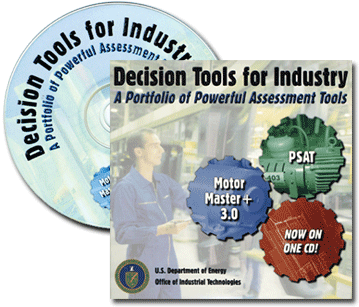 MotorMaster+ is a management tool for selecting energy-efficient electric motors. It enables users to compare more than 20,000 commercially available motors on the basis of their nameplate energy-efficiency ratings, purchase price and operating parameters. Version 3.0 of the software contains enhanced motor inventory management tools, maintenance log tracking, efficiency analysis, savings evaluation, energy accounting, and environmental reporting capabilities - in short, almost everything an engineer, facilities manager or purchasing agent needs to make dollars-and-sense decisions about electric motors.
MotorMaster+ is a management tool for selecting energy-efficient electric motors. It enables users to compare more than 20,000 commercially available motors on the basis of their nameplate energy-efficiency ratings, purchase price and operating parameters. Version 3.0 of the software contains enhanced motor inventory management tools, maintenance log tracking, efficiency analysis, savings evaluation, energy accounting, and environmental reporting capabilities - in short, almost everything an engineer, facilities manager or purchasing agent needs to make dollars-and-sense decisions about electric motors.
High-Efficiency Transformers, Too
Weyerhaeuser's corporate energy policy extends to its hundreds of transformers. A federal law comparable to EPAct doesn't exist for transformers yet, but efficiency ratings are tops among the factors Weyerhaeuser takes into account when it buys new ones. For maximum cost-effective energy efficiency, all transformers currently purchased at Weyerhaeuser are copper-wound, cast-coil models that are evaluated using a life-cycle- cost analysis.
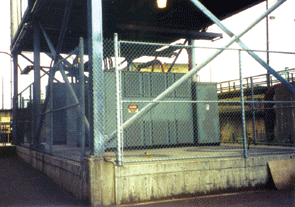 Main distribution transformers at Longview
Main distribution transformers at Longview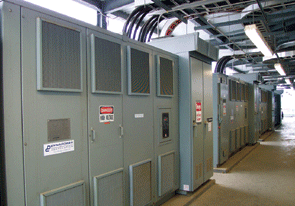 2000-kVA drive transformers at Springfield
2000-kVA drive transformers at SpringfieldThree of many examples found among Weyerhaeuser's 280 facilities are power distribution transformers for its Longview Complex, in Longview, Washington. Here, one 5000-kVA transformer supplies 2,400-V power for certain large motors, while the 600-V-rated secondaries of two smaller 2500-kVA units supply 575-V motors.
Other typical examples are the six 2000-kVA transformers serving the #2 paper machine drive at Weyerhaeuser's Springfield, Oregon, mill.
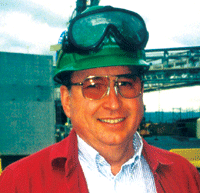 Jerry Bland
Jerry BlandJerry Bland, E&I superintendent at the Longview Complex, explains that cast-coil transformers were selected for both of those reasons, and especially because of their known reliability in harsh environments. "We have a lot of corrosive atmospheres here, so we don't use any aluminum-wound transformers." Back to Top
The Principals
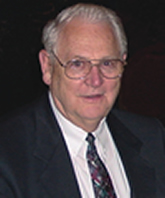 John Holmquist is senior scientist, Electrical Power and Energy, for Weyerhaeuser Engineering. Mr. Holmquist is an electrical engineer and a Life Fellow Member of the Institute of Electrical & Electronics Engineers (IEEE). Among his recent accomplishments is authorship of the Weyerhaeuser Company's corporate energy policy dealing with electric motors. Information about Weyerhaeuser and its many environmentally friendly initiatives can be found at www.weyerhaeuser.com.
John Holmquist is senior scientist, Electrical Power and Energy, for Weyerhaeuser Engineering. Mr. Holmquist is an electrical engineer and a Life Fellow Member of the Institute of Electrical & Electronics Engineers (IEEE). Among his recent accomplishments is authorship of the Weyerhaeuser Company's corporate energy policy dealing with electric motors. Information about Weyerhaeuser and its many environmentally friendly initiatives can be found at www.weyerhaeuser.com. Jim Rooks is founder and president of J&R Consulting, Inc., Tigard, Oregon. An authority on energy efficiency issues, Mr. Rooks has provided extensive electrical engineering consulting services to the Weyerhaeuser Company and other forest products organizations. Mr. Rooks can be reached at [email protected], (503) 524-4640.
Jim Rooks is founder and president of J&R Consulting, Inc., Tigard, Oregon. An authority on energy efficiency issues, Mr. Rooks has provided extensive electrical engineering consulting services to the Weyerhaeuser Company and other forest products organizations. Mr. Rooks can be reached at [email protected], (503) 524-4640.
Footnotes
-
 Note that table numbers may vary among the several editions and revisions of NEMA MG 1 published since EPAct became law. Efficiency data for EPAct-level and NEMA Premium motors are available from Copper Development Association Inc.
Note that table numbers may vary among the several editions and revisions of NEMA MG 1 published since EPAct became law. Efficiency data for EPAct-level and NEMA Premium motors are available from Copper Development Association Inc. -
 Use of the NEMA Premium term and label is voluntary, even among NEMA members. Lack of a NEMA Premium label does not necessarily mean that a particular motor does not meet the standards. It pays to check the efficiency rating of a particular motor against the published NEMA standards.
Use of the NEMA Premium term and label is voluntary, even among NEMA members. Lack of a NEMA Premium label does not necessarily mean that a particular motor does not meet the standards. It pays to check the efficiency rating of a particular motor against the published NEMA standards. -
 See Holmquist, J.R., "Reasons for Using IEEE Standard 841-1994 Motors for the Forest Products Industry," Proceedings of Pulp and Paper Industry Technical Conference, Portland, Maine, June 21-26, 1998, pages 87-95.
See Holmquist, J.R., "Reasons for Using IEEE Standard 841-1994 Motors for the Forest Products Industry," Proceedings of Pulp and Paper Industry Technical Conference, Portland, Maine, June 21-26, 1998, pages 87-95. -
 Holmquist, op.cit.
Holmquist, op.cit.
